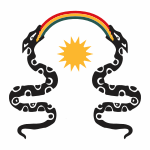Manco Cápac
You can help expand this article with text translated from the corresponding article in Spanish. (January 2023) Click [show] for important translation instructions.
|
| Manqu Qhapaq | |
|---|---|
Mama Uqllu | |
| Father | Apu Tambo[2] |
Manco Cápac (before c. 1200 – c. 1230;
Biography
Origin
Manco Cápac was born in Tamputoco, which according to some[4] is located in the present-day province of Pumaurco, in Peru. The city usually served as a refuge for many people escaping the Aymaran invasions [5] of the Altiplano. His father was named Apu Tambo.[2] Manco Cápac and his family lived a nomadic lifestyle.[6]
Foundation of Cusco

After the death of his father, Manco Capac had to succeed him as the head of the ayllu, to which belonged several dozens of families.[7] The members of the ayllu were nomads, and the trajectory of their journeys through the Altiplano resembles the journey described in the legend of the Ayar brothers. Upon arriving to the Cusco valley, they defeated three small tribes that lived there; the Sahuares, Huallas and Alcahuisas,[6] and then settled in a swampy area between two small streams, that today corresponds with the main plaza of the city of Cusco.[8] The recently founded city was divided into four districts; Chumbicancha, Quinticancha, Sairecancha and Yarambuycancha.[9]
Manco Cápac's tribe, or ayllu, only occupied a small fraction of the Cusco valley, the rest of it being inhabited by larger and more powerful tribes, who often would threaten the city. Located at north of the city there was a confederated lordship of Ayarmacas and Pinaguas. All these tribes regarded Manco Cápac and his ayllu as invaders, and would often attack them. Manco Cápac, and later his son and successor Sinchi Roca would often have to defend the city against the other tribes.[10]
Death

Manqu Qhapaq died of a natural death and left his son, Sinchi Roca, as his successor in Cusco. His body was mummified and remained in the city until the reign of Pachacuti, who ordered its move to the Temple of the Sun on Isla del Sol. In Cusco there remained only a statue erected in his honor.
Mythological origin
Manco Cápac is the protagonist of the two main legends that explain the origin of the
Legend of the Ayar brothers
In this legend, Manco Cápac (Ayar Manco) was the son of Viracocha of Paqariq Tampu (six leagues or 25 km south of Cusco). He and his brothers (Ayar Auca, Ayar Cachi and Ayar Uchu) and sisters (Mama Ocllo, Mama Huaco, Mama Raua and Mama Ipacura) lived near Cusco at Paqariq Tampu, and they united their people with other tribes encountered in their travels. They sought to conquer the tribes of the Cusco Valley. This legend also incorporates the golden staff, thought to have been given to Manco Cápac by his father. Accounts vary, but according to some versions of the legend, the Manco got rid of his three brothers, trapping them or turning them into stone, thus becoming the leader of Cusco. He married his older sister, Mama Occlo, and they begot a son named Sinchi Roca.[11]
Legend of Manqu Qhapaq and Mama Ocllo
In this second legend, Manco Cápac was a son of the sun god
However, given the absence of a written tradition recounting this tale before the publication of
In fiction
The Scrooge McDuck comic book The Son of the Sun, written by Don Rosa, features Manco Cápac as the original owner of various lost treasures.
In the first chapter of Herman Melville's The Confidence-Man the sudden appearance at sunrise on April 1 of a mysterious fictional character is compared to Cápac's appearance out of Lake Titicaca.
In
In British author Anthony Horowitz's fantasy-thriller book series The Power of Five, Manco Cápac is the son of Inti, and one of five children destined to keep the universe safe from the forces of evil. Cápac is reincarnated in the 21st century as a Peruvian street beggar called Pedro.
Kuzco, the main character from
Heritage
The car float Manco Capac operates across Lake Titicaca between PeruRail's railhead at Puno and the port of Guaqui in Bolivia.[12]
References
- S2CID 145472763.
- ^ a b Arturo Gómez Alarcón, Los Incas, Manco Cápac.
- ISBN 9781420941142
- ^ Pedro Cortázar, Documental del Perú: Cusco. p. 148
- ^ Soriano 1990 p. 36
- ^ a b Soriano 1990 p. 47
- ^ Soriano 1990 p. 41
- ^ Incan city of Cusco, The foundation and actions of the Manco Capac government Archived 2011-06-02 at the Wayback Machine (in Spanish)
- Víctor Anglés Vargas, Historia del Cusco incaico, p. 290
- ^ Soriano 1990 p. 51
- ISBN 9781463688653
- ^ Wikipedia Foundation, PeruRail, accessed 19 February 2020
Bibliography
Soriano, Waldemar Esponoza (1990). Los Incas. Economia, Sociedad Y Estado En La Era Del Tahuantinsuyo. Amaru Editores.

